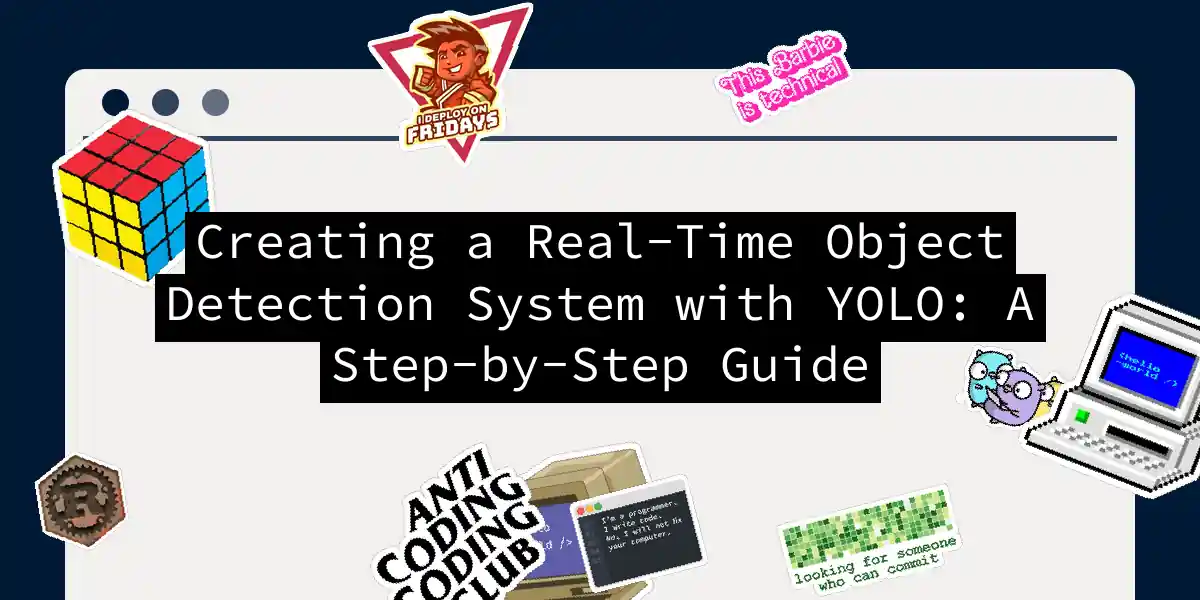What is YOLO?
Before we dive into the nitty-gritty of creating a real-time object detection system, let’s start with the basics. YOLO, which stands for “You Only Look Once,” is a revolutionary object detection algorithm developed by Joseph Redmon and Ali Farhadi in 2015. Unlike its predecessors, YOLO processes the entire image in one pass, making it incredibly fast and efficient. This single-stage detector uses a convolutional neural network (CNN) to predict both the class and location of objects in an image[3].
How YOLO Works
To understand why YOLO is so powerful, let’s break down its workflow:
- Grid Division: YOLO divides the input image into a grid of cells. Each cell is responsible for predicting the presence of an object and its bounding box coordinates.
- Bounding Box Predictions: For each cell, YOLO generates a number of bounding boxes, each with a confidence score indicating how certain the model is that the box encloses an object.
- Class Predictions: Along with the bounding boxes, YOLO predicts the class of the object within each box.
- Final Prediction: After making all predictions, YOLO selects the bounding box with the highest confidence level and the associated object class as its final prediction[5].
Here’s a simplified flowchart to illustrate this process:
Setting Up Your Environment
Before you start coding, you need to set up your environment. Here are the steps to follow:
Dependencies
You will need the following dependencies:
- OpenCV 4.2.0 or later
- Python 3.6 or later
- NumPy
You can install these using pip:
pip install numpy opencv-python
Downloading YOLO Weights and Configurations
You need to download the pre-trained YOLO weights and configurations. Here’s how you can do it:
- Download
yolov3.weightsandyolov3-tiny.weightsand place them in a folder namedweights. - Download
yolov3.cfgandyolov3-tiny.cfgand place them in a folder namedcfg.
You can find these files in various repositories or download them from the official YOLO website.
Implementing YOLO in Python
Here’s a step-by-step guide to implementing YOLO in Python using OpenCV:
Loading the YOLO Model
First, you need to load the YOLO model using OpenCV’s DNN module:
import cv2
import numpy as np
# Load YOLOv3 model
net = cv2.dnn.readNet("weights/yolov3.weights", "cfg/yolov3.cfg")
Loading Classes
Next, load the COCO dataset classes that YOLO is trained on:
classes = []
with open("coco.names", "r") as f:
classes = [line.strip() for line in f.readlines()]
Real-Time Detection
Here’s an example of how to perform real-time object detection using your webcam:
# Initialize the webcam
cap = cv2.VideoCapture(0)
while True:
# Read frame from webcam
ret, frame = cap.read()
if not ret:
break
# Get the height and width of the frame
height, width, _ = frame.shape
# Create a blob from the frame
blob = cv2.dnn.blobFromImage(frame, 1/255, (416, 416), swapRB=True, crop=False)
# Set the input for the YOLO model
net.setInput(blob)
# Get the output layers
output_layers = net.getUnconnectedOutLayersNames()
# Forward pass to get the detections
outputs = net.forward(output_layers)
# Lists to store the detected bounding boxes, classes, and confidence scores
boxes = []
class_ids = []
confidences = []
for output in outputs:
for detection in output:
scores = detection[5:]
class_id = np.argmax(scores)
confidence = scores[class_id]
if confidence > 0.5:
center_x = int(detection[0] * width)
center_y = int(detection[1] * height)
w = int(detection[2] * width)
h = int(detection[3] * height)
x = int(center_x - w / 2)
y = int(center_y - h / 2)
boxes.append([x, y, w, h])
class_ids.append(class_id)
confidences.append(float(confidence))
# Apply non-maximum suppression to suppress overlapping boxes
indices = cv2.dnn.NMSBoxes(boxes, confidences, 0.5, 0.4)
if len(indices) > 0:
for i in indices.flatten():
x, y = (boxes[i][0], boxes[i][1])
w, h = (boxes[i][2], boxes[i][3])
# Draw the bounding box
cv2.rectangle(frame, (x, y), (x + w, y + h), (255, 0, 0), 2)
# Draw the class label
cv2.putText(frame, f"{classes[class_ids[i]]} {confidences[i]:.2f}", (x, y - 5), cv2.FONT_HERSHEY_SIMPLEX, 0.5, (255, 0, 0), 2)
# Display the output
cv2.imshow('Frame', frame)
if cv2.waitKey(1) & 0xFF == ord('q'):
break
# Release the capture and close all windows
cap.release()
cv2.destroyAllWindows()
This script will capture video from your webcam, detect objects in real-time, and display the bounding boxes along with the class labels.
Real-World Applications
YOLO’s real-time capabilities make it a versatile tool for various applications:
- Video Surveillance: YOLO can be used to monitor and detect objects in real-time, making it ideal for security systems.
- Autonomous Driving: In self-driving cars, YOLO can help detect pedestrians, cars, and other objects on the road.
- Robotics: YOLO can be integrated into robots to enable them to detect and interact with objects in their environment.
Here’s a sequence diagram showing how YOLO might be used in an autonomous driving system:
Conclusion
Creating a real-time object detection system with YOLO is both challenging and rewarding. With its single-stage detection approach and real-time capabilities, YOLO stands out as a powerful tool in the field of computer vision. By following the steps outlined in this guide, you can implement YOLO in your own projects and explore its vast potential in various real-world applications.
Remember, the key to mastering YOLO is practice and patience. So, go ahead, dive into the code, and see the magic of real-time object detection unfold before your eyes
